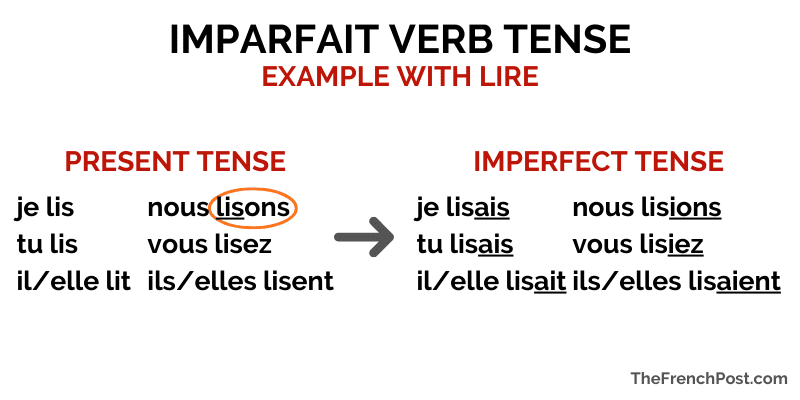
Learning about the French past tenses usually starts with the passé composé, but that’s not the end of the common French past tenses. To get a strong grasp of French past tenses, you’ll also need to master the French imparfait tense.
Learning the imparfait requires thinking of how you’re speaking about the past a little more critically than you do in English. After all, in English, you’re pretty much either talking in past tense or you’re not, right? Not so for French.
For normal, everyday speaking and writing, you need to distinguish between two types of past tenses: the passé composé and the French imperfect tense.
When TO use the French imparfait (and not passé composé)
Every time it is necessary to use the past tense in French, you will need to decide which past tense to use. The imparfait tense is used for…
Verbs that “set the scene” before specific event verbs happen
Il pleuvait, et les gens étaient mécontents. (“It was raining, and people were unhappy.”)
Verbs that happened continually or habitually
Je mangeais des crêpes tous les samedis matin. (“I ate pancakes every Saturday morning.”)
Verbs that are referring to something that “used to” happen
Ce restaurant servait des pizzas. (“This restaurant used to serve pizza.”)
Verbs referring to events that were interrupted (by the passé composé)
Je lisais, quand le téléphone a sonné (“I was reading [imparfait] , when the phone rang [passé composé])
You can also check out our full post on when to use imparfait versus passé composé.
How TO conjugate the imperfect tense
Now that you have an idea of when you’ll need it , it’s time to learn how to conjugate the imparfait tense. Fortunately, this tense is very simple to conjugate, and all the forms besides the être conjugation are regular.
You’ll take the nous form of a present tense verb, drop the -ons ending, and add on the imparfait endings shown below.
We’ll use lire (“to read”) as an example:

As you can see from the chart, the imparfait verb endings are:
| je: root + ais | nous: root + ions |
| tu: root + ais | vous: root + iez |
| il/elle: root + ait | ils/elles: root + aient |
The only irregular French imparfait verb: être
The only exception to the rule of using the nous present tense form to conjugate the imperfect tense is the verb être. Its root form in the imperfect tense is ét+verb ending.
However, the imperfect verb endings are still regular. The full conjugation chart for être is below.
| j’étais | nous étions |
| tu étais | vous étiez |
| il était | ils étaient |
Spelling exceptions in the French imparfait
Generally, the idea behind the imparfait is that the base sound, or the root, should be the same for all conjugations of the word. But letters like g and c can be “hard” or “soft”, depending on the vowel that follows them (we have posts on French spelling and French pronunciation that clarify these points). Here are the two spelling rules to know for imparfait.
Verb root forms that end in g
Add an e after the g if the next letter would normally be an a (in other words, the je, tu, il, and ils forms) so that the g sound stays soft. This change is necessary because a g followed by an a would normally be a hard sound, but we want it to be a soft sound. For example:
Nous mangions (no extra e), but
Je mangeais (with an e)
Verb root forms that end in c
Change the c to a cedilla (ç) to keep the c soft if the next letter would normally be an a (as above, the je/tu/il/ils forms). For example:
Nous lancions (no cedilla) but
Tu lançais (with cedilla)
Next Steps
That’s the end of this lesson, but there’s a lot to learn about the imparfait tense. You might want to learn more about how to choose between it and passé composé, or you might be ready to move on to another past tense: the plus que parfait, which is how to talk about one event that happened before another past event.



